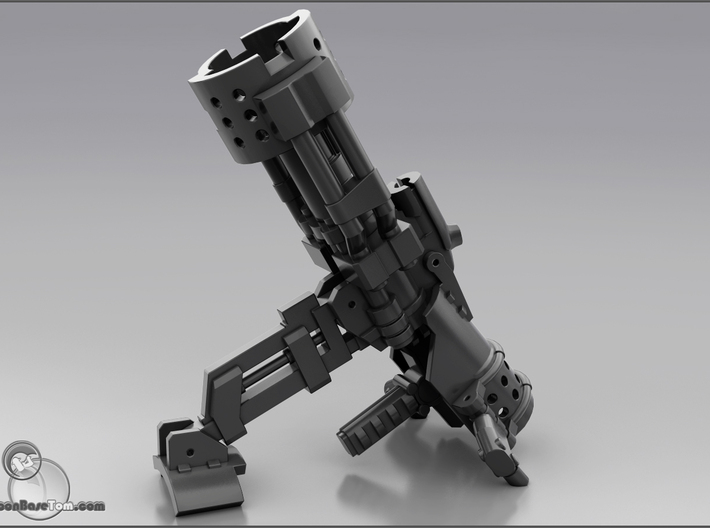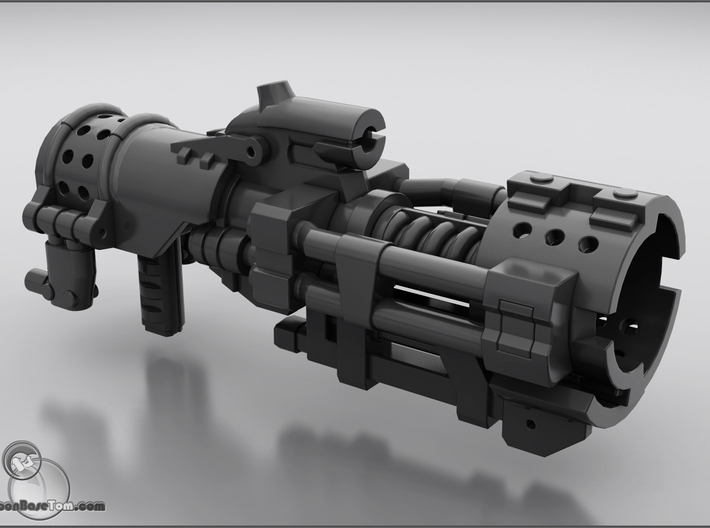Directorate Officer


OUT OF CHARACTER INFORMATION
- Intent: To provide a light mortar in the Lucerne Personal Defense line-up
- Image Source: here
- Canon Link: N/A
- Primary Source: N/A
- Manufacturer: Lucerne Personal Defense
- Affiliation: Directorate, Silver Jedi, Closed-Market
- Model: LPD-32 Flamefist Mortar
- Modularity: Ammunition
Production: Mass-Produced
- Material: Mirrsteel barrel and receiver, ceramisteel internal components and bracing, Permex furniture
- Classification: Mortar
- Size: Very Large
- Weight: Heavy
- Ammunition Type: 1 Shell
- Ammunition Capacity: 1
Reload Speed: Slow
- Effective Range: Battlefield
- Rate of Fire: Slow
- Stopping Power: Very High
- Recoil: High
Reconfigurable Firing Configuration: The Flamefist can be configured to fire in two different ergonomic firing modes. Most commonly, the Flamefist is used a conventional mortar, with a base plate and a bipod supporting the Flamefist on the ground for indirect fire. It can also fired over the shoulder in a manner similar to many rocket launchers, the recoil is very stout except for the strongest of individuals.
Variable Shells: The Flamefist can fire a variety of different shell types aside from its basic high explosive shell. These munitions include smoke, cyroban, T-238, Plank Gas, and many more.
Oversized Controls: The Flamefist uses larger than normal controls, allowing it to be more easily manipulated by soldiers in heavy armor or larger species such as Houks and Wookiees, and by extension, Arrichit series Synthetic Soldiers.
Iron Sights: The Flamefist uses iron aperture sights enclosed into a protective tube for when the weapon is used in the shoulder fired mode.
- Heavy Hitting: The Flamefist fires a fairly large payload, which in most cases makes it a fairly potent weapon, allowing individual troopers to take out armored vehicles or fortified positions.
- Long Range: The Flamefist's shells have a fair amount of propellant, which allows shells to potentially transverse across the length of many battlefields.
- Modular: The Flamefist, like many projectile weapons, is a relatively adaptable weapon because it can use different types of ammunition. While high explosives and shaped charges are by far the most commonly used rounds, the Flamefist can also use specialty munitions to achieve a variety of other effects.
- Heavy: The Flamefist is a big and heavy weapon, which makes it unwieldly and tiring to carry over long distances for many users. Ammunition is also quite large and relatively heavy, which means that only a handful of shells can be carried by an individual.
- Slow Fire Rate: Being a single shot weapon, the Flamefist lacks the rate of fire common to most modern weapons.
- Ballistic Curve: The Flamefist's projectiles are fairly heavy, which gives them a pronounced ballistic arc, which requires some effective ballistic knowledge and skill to effectively use. It also means that precise accuracy with the weapon over long-ranges is almost impossible unless precise firing solutions are laboriously calculated and the weapon very carefully aligned.
The Flamefist is a single-man portable mortar designed to give infantry the ability to successfully attack armored vehicles and fortified positions. This is typically down through indirect fire, with the weapon braced into the ground through its base plate and bipod. However, the weapon can be fired from the shoulder, though the recoil is not inconsiderable. In either case, the Flamefist lobs out a heavy shell, typically packed full of high explosives which puts it on the borderline between a personal weapon and a dedicated artillery piece. Either way, while it fulfills a blunt instrument role, the Flamefist does have some refinements characteristic of Lucerne Personal Defense's products.
The Flamefist uses a heavy Mirrsteel barrel to hold a relatively large shell that only has a relatively small amount of propellant in it. Thus when the spring-loaded firing pin is release by the weapon's trigger, the propellant charge within the shell rapidly expands and is used up entirely before the shell leaves the Flamefist's barrel. This provides only a low velocity to the Flamefist's shell (and incidentally makes it a pretty quite weapon for its class), which largely relies on the contents of its shell to inflict damage rather than kinetic energy. The following are the more common shells used by the Flamefist:
High Explosive: This shell is filled with Nergon-14 primed with a Chepatite Impact Explosive detonation charge. This shell is about as powerful as a starfighter grade proton torpedo and produces a large, explosion approximately 20 meters in diameter upon detonation. It typically is used for indirect bombardment, especially against lightly protected groups of targets.
Anti-Armor: This shell uses a shaped charge of Nergon-14 primed with a Chepatite Impact Explosive detonation charge. Unlike the high explosive shell, the Anti-Armor shells is much more focused in nature, directing almost all of its energy in a forward, kinetic jet designed to penetrate through heavy vehicle armor found on tanks, walkers, and other heavy vehicles.
Ion: This shell carries an ion charge, which produces an intense electromagnetic pulse that can fry or temporarily disable electronics in such things such as droids, weapons, and vehicles.
Smoke: This shell produces an erupting stream of smoke used to mark sites for other friendly units, obscure the vision of opposing forces, or to “smoke out” occupants in enclosed spaces.
T-238 Shell: This shell produces a cloud of T-238 gas, which causes intense and immediate nausea and vomiting in most organics. It is most often used for riot control purposes or to combat creatures.
Coma Gas: This shell produces a cloud of coma gas, which typically knocks organics unconscious if only a few breathes of the gas are inhaled. This is typically used to subdue or capture organic targets such as people or creatures.
Cryoban: This shell releases a cloud of chilling Cyroban. This intense freezing effect is not only used to damage or destroy targets, but also sees use in putting out fires and combating area of effect thermal weapons.
Incendiary: This shell releases a cloud of fine thermite powder that is ignited on impact by a detonite priming charge. It produces a brief area of conflagration approximately 20 meters in diameter. The thermite burns out fairly quickly, meaning that for sustained fires to exist, something in the area must already be flammable.
Plank Gas: This shell releases a cloud of plank gas, which rapidly corrodes not only flesh, but eats through metal objects as well. While devastating, Plank Gas also dissipates fairly quickly in open spaces, which limits the gas' effectiveness.
The variety of ammunition available gives small infantry units many options for attacking opponents, which makes it particularly popular with smaller organizations who sometimes cannot afford expensive artillery pieces or dedicate personnel exclusively to artillery roles. Light infantry organizations appreciate for similar reasons, especially since it often means that they do not have to ask for out of organization fire support. While most Flamefists are organically assigned within infantry units as supplemental weapons, a handful of organizations using Flamefists have organized them into dedicated batteries, which allows them to almost continuously bombard targets. Regardless of the doctrine, Lucerne Personal Defense expects sales of these weapons to be steady for years to comes.








